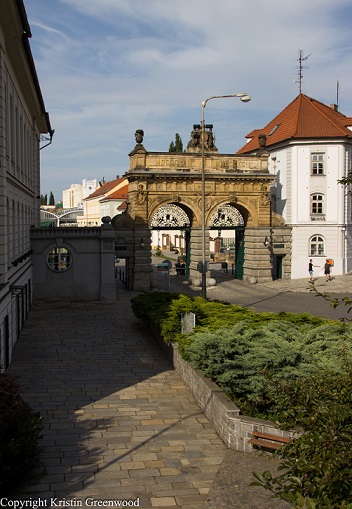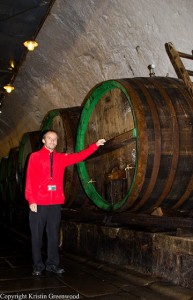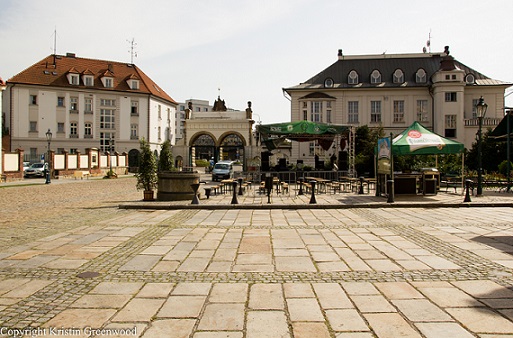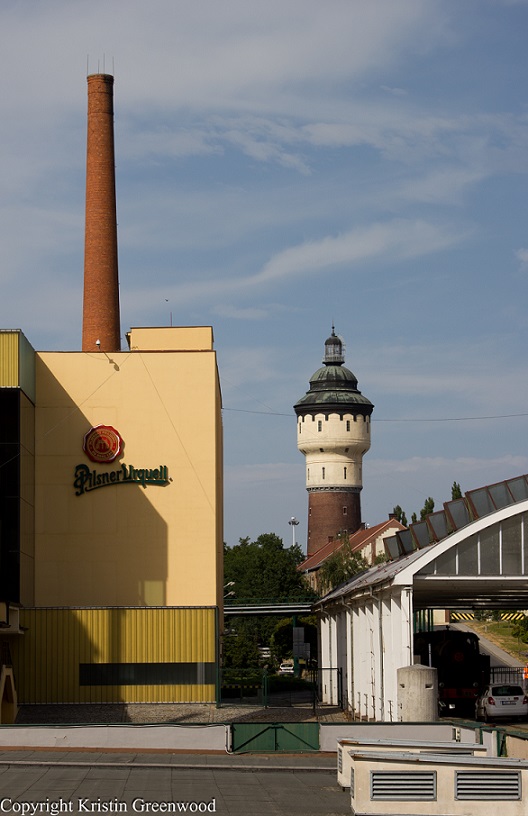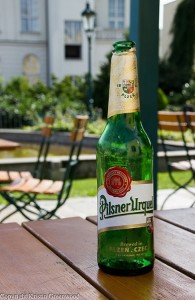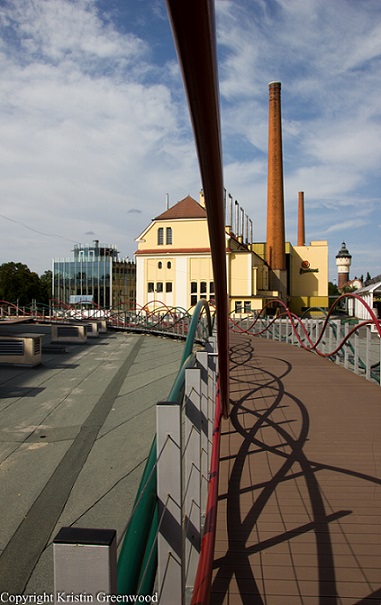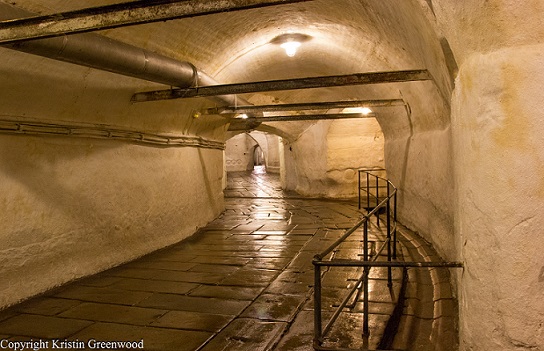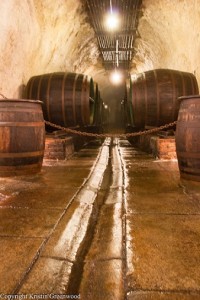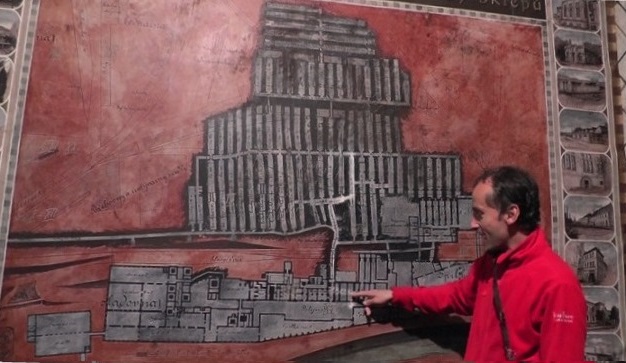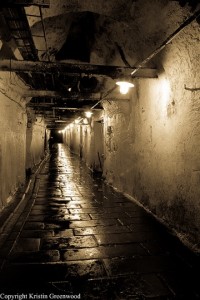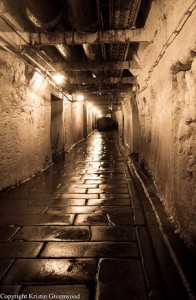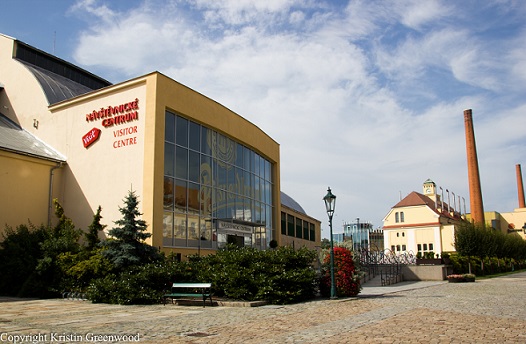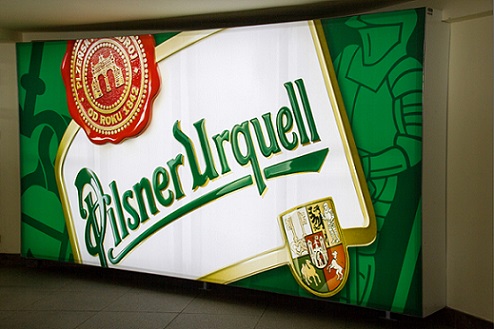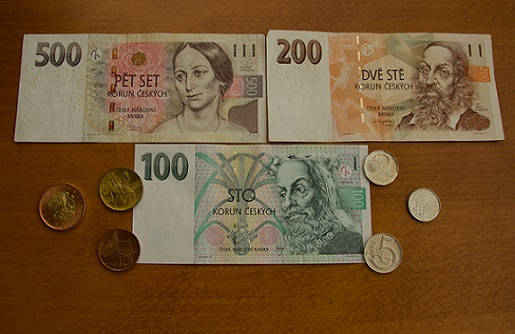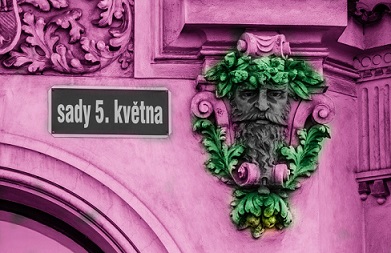Visit of Pilsner Urquell Brewery & history of beer
Number One! This is a target deeply rooted within us since childhood. Best in class, honours at university, employee of the month and the target list goes in on and on. Achieving number one is very special but imagine something bigger than that?
How it would feel like to be the first one at creating something special? So different and unique that thousands of people imitated your way of making it for generations to come.
This is how the Bavarian brewmaster Josef Groll and the members of the 260 licensed brewers must have felt on 11 November 1842 when they first tapped the beer barrel in Pilsen. When they poured the beer into the beer pitcher it seemed different. It looked clear and golden crisp when poured into an ordinary glass.
An ordinary glass? Beer wasn’t served in beer glasses back then. Either metal or wooden pitchers were used. This golden colour like the highly regarded precious metal was a sign of a majestic moment.
As the first drops of beer touched their tongues I wonder whether they knew for sure that they had improved brewmaking forever. Pilsner Beer was born and its legacy is even today copied by most Pilsner Beer makers in the world.
One might ask, how does a Bavarian brewmaster create such a beer in Bohemia, today a region in the Czech Republic, and not at home?
Well it all comes down to passion. If you are passionate about something then the world is your gateway to greatness.
The people of Pilsen definitely had a lot of passion in their blood. Back in 1295, when the King of Bohemia, King Wenceslaus II founded Pilsen, in Czech “Plzen”, he made the city a royal city and granted the 260 citizens the privilege to brew beer from their houses. This privilege was attached to the house itself rather than individual families and anyone who lived inside one of those houses was allowed to brew beer. In those days, only the townsmen of royal towns, monks and noble men were allowed to brew beer. The brewing of beer continued during the following centuries. There were no standards, no special processes and everyone who brewed beer made it in a different way. It was a mess and one day in February 1838, several of the city’s brewers spilt 36 barrels, filled with undrinkable beer, in front of the town hall in a protest at poor standards. After that the 260 licensed brewers decided to unite and to give beer a proper home in their Bürgerbrauerei, Měšťanský pivovar in Czech and Citizens Brewery in English, which was set up outside of town and opened in 1842. Today these old laws are obsolete and anyone can brew beer in the Czech Republic.
As for Josef Groll, his passion was urged to him through his friend Martin Stelzer. Martin Stelzer was given the task by the Citizens Brewery to build a modern brewery for the production of bottom fermented beer and so he travelled around the world to study how other breweries were set up and brew beer. On his journey he met Josef Groll in Bavaria. Martin bet with Josef, that he would not come to Pilsen and brew such a good beer like he made in Vilshoven.
Josef came to Pilsen and proved his friend wrong and created the Pilsner Urquell beer as the first brewmaster and since that day, every brewmaster has created it the same way.
Our tour guide at the Pilsner Urquell brewery, Jan Dienstbier, reflects the historical Pilsen passion for beer. His family name suggests he was born to do this job. Although he is Czech the name has the German meaning Dienst=service/duty and Bier=beer. In the past, the German language was commonly used in Bohemia. Back in the 19th century, Bohemia was part of the Austro-Hungarian Empire and this was also the reason why Pilsner Urquell was given a German name in 1898 following numerous breaches of the previous trademarked name “Pilsner Bier”. Urquell means the ancient source. Jan’s passion immediately came clear when he introduced us to the background of the brewery at the grand wall containing the world of SAB Miller (South African Breweries) the corporation that now owns the Pilsner Urquell brand. How could he remember all those names and facts?
After the introduction we went into the courtyard in front of visitor centre. On our right we saw the entrance gate called Jubilee Gate, which, on our arrival, reminded Paul of Charlie and the Chocolate Factory. The gate was built in 1892 which was the 50th anniversary of when the brewery was founded. It was made out of sand stone and the pillars were made from granite. After the gate, was a little festival square looking like a mini beer garden. At the time of our visit there was even a stage for a concert set up. The space is also used during the traditional Oktoberfest. Opposite the square was the Pilsner Urquell Souvenir Shop and the restaurant Na Spilce.
When we turned left, we could see the 50 metre high water tower which was inspired by a Dutch lighthouse. Jan explained to us that this was to symbolise an ocean of beer to people arriving in Pilsen. Next to the tower stands the yellow old brewhouse and significantly more modern is a glass building right beside it which is the new brewhouse.
We headed towards the water tower and stopped in front of an old locomotive, called Gambrinus. The brewery was one of the first breweries in the world that had their own railroad system. You can still see parts of the railroad track within the cobbled stone yard. The brewery is and always has been keeping up with modern technology whilst staying true to values and traditions. Traditions are another key ingredient which makes this brewery so special. Next to the locomotive is a horse pulled old cart which is still used today. Every week, a woman delivers Pilsner Urquell beer to the most traditional pubs in Pilsen.
Another tradition still alive here – Pilsner Urquell employ eight coopers who are tasked with making the traditional oak wooden beer barrels. Although nowadays big CK tanks are mainly used for the fermentation, which means the maturing of the beer, the brewery wants to keep this special craft alive. It has always been passed down from generation to generation.
Beer barrels need some special treatment otherwise the wood can negatively influence the beer. During a recent flight in the US, we got to speak to a very friendly chap called Todd from Fresno, California. He also loves beer and he told us about special beers that are barreled in old bourbon barrels. After doing some research, we found that the Kentucky Bourbon Barrel Ale is said beer. It is stored inside the bourbon barrels for 6 weeks and after that, this beer tastes completely different.
The ride to our next stop at the factory was conducted on a modern bus suitable for a big group. This took us to the filling plant, which is one the most modern ones in Europe. As you enter the 20,000m² building, you can right away hear the rattling of the bottles. It gets even louder as you go upstairs to the second floor facing the top floor of filling lines where thousands of little green bottles are being washed, inspected by the flashy bottle inspector (where a stroboscopic light is used so that a camera machine can identify any faulty bottles) and then being filled. The filling plant has 4 filling lines and can simultaneously handle four different brands of beer. It operates 362 days a year (except at Christmas and New Year’s Day) and it can fill 80,000 plastic bottles, 120,000 glass bottles and 39,000 cans in one hour.
The brewery uses green bottles with thick glass for the domestic market and thinner ones for abroad. The reason for that is that the domestic bottles are being returned and reused whereas the others remain somewhere around the world.
Having passed the bottle inspector and seeing the can line at the end, the bus brought us to another modern structure of the brewery. It was the biggest elevator in the Czech Republic suitable for up to 50 people. There was enough space for a small bus. The elevator brought us to the 2nd floor into the movie theatre where a 7 minute film revealed to us the secrets of the production of Pilsner Urquell Beer.
Before the revelation on how the beer is made, Jan revealed to us another interesting fact. The brewery is visited by approximately 250,000 people each year. The number is increasing every year. Most visitors are Czech, the second most visitors are Germans and funnily enough the third place goes to the Taiwanese. If you would have asked that question in a quiz then no one would have answered Taiwan. Apparently the Taiwanese love to travel, especially to the Czech Republic and Austria which they find very romantic.
The movie theatre is a round room. The film showed that Pilsner Urquell is made of 3 gifts of nature which are barley to create malt, the pricy and noble Saaz Hops and water (constituting the remaining 92% of the beer). It is not any kind of water, it is special water from their own Artesian wells purer than the water for infants. One of the wells is 100 metres deep. This is almost the same depth, as the height of the St Bartholomew Cathedral in Pilsen. Water is also the next sound you can hear after the film inside the Pilsner Urquell Exhibition. Here you can have a look at the rock formations and taste the difference between barley and malt which is the soul of beer.
Unlike most breweries, Pilsner Urquell continues to use their own malt.
How Does Barley Become Malt?
It is simple, although it took me some time to understand it properly.
Barley is a type of grain which you can sometimes see in corn fields. It is giving the sweetness to the beer as it is a fermentable starch source. To save money, some breweries even use cheaper versions mixing it with wheat or rice.
The grain is cleaned and soaked in water for 30 hours and thereafter they let the barley germinate for 5 days. Germination means that the grain is kind of opening up and grows. That is called sprouting when the starches are converted into sugar.
On the 6th day the barley is dried in the oven, or kiln, and it becomes malt.
The more barley is dried, the darker the colour of the beer gets.
Soon after we inspected the malt, a projected monitor showed us fields of hops where Jan revealed another interesting fact which is that 70% of all Japanese beers use Czech Saaz Hops. If our journey ever takes us to Japan, then we will definitely try some of their beers.
Czech Saaz Hops is one out four European noble types of hops. It is the most expensive hops in the world.
From the exhibition area, we walked downstairs into the old brewhouse. It is not being used anymore and was converted into a museum in 2004. The first things that you can see inside are giant mash kettles. They are made out of copper and around the lower part are shiny white tiles. The Pilsner Urquell mash kettles are very special because they have flames inside of them providing even more heat together with the copper. Most breweries use steam. After our sneak peak into the mash kettle, we went upstairs and looked at a mash tun which was part of the old brewhouse. The mash tun looks similar to the mash kettle although copper is not necessary inside of it.
A direct walkway goes from the old brewhouse into the new brewhouse. Inside you can literally feel the brewing process on your skin. It is very hot, loud and above all ultra-modern.
The brewing process was another challenge for me to learn about. It really is quite complicated and every brewmaster has their own ways of working their craft.
Inside the brewery, the three gifts of nature are being mixed together and boiled. Here are 3 points which explain this complicated creation.
1. Mashing
The milled malt goes in powder form together with water into the mash tun and the mixture is being sent to the mash kettle where it is being heated up. Mashing (in German Maischen) is an old word for mixing. During the mashing process, the enzymes in the malt break down the starches and convert them into fermentable sugars which are extracted from the malt.
The mashing process at Pilsner Urquell is repeated three times, called triple mashing. Which means that one third of the mixture is separately transferred into the mash kettle and added back to the remaining mash and this process is done 3 times giving Pilsner Urquell its unique flavour, aroma and colour. The result is a mixture called sweet wort because of all the sugar extracted from the grain.
2. Lautering
The sweet wort is then drained off the grains inside another tun called lauter tun. This is a big tun made out of metal or steel. Lautering is just another word for filtering or cleaning and it is very important so the brewer can obtain as much fermentable liquid from the grain, as possible.
3. Hopping
The next step is when the sweet wort goes into the copper where the all-important hops is added. Hops is the spice of beer. It is the perfect counter balance to the sugars extracted from the malt. From the copper, the mixture flows into the whirlpool where it is heated up once again and that is the final step of the brewing process.
The next stop was the Hall of Fame in which you can right away see the most important person for Pilsner Urquell Beer, Josef Groll. The Hall of Fame showcases Bohemian crystal glasses which were used for some famous visitors. One of them was the Caesar of the Austro-Hungarian Empire, Franz Josef I. You can also see old documents, medals which the brewery won from beer awards and the Holy Grail of the brewery, the original open copper kettle in which the first Pilsner Urquell Beer was created. Unlike the other kettles we had seen in the old and new brewhouses, looked this one like an old giant copper box and inside of it were many coins and one minor hole. The Czech Republic seems to be full of legends and as for the coins inside the kettle, they also have a legend. Apparently if a woman manages to throw a coin through the hole then she will become pregnant within year.
The final part of the tour was the cold cellars of the brewery. After the beer is brewed in the brewhouse it has to be cooled down to a temperature suitable for the yeast to work their magic during the fermentation process.
Back in the days most beers were top fermented beers because they were quicker and easier to make plus these beers fermented and still are fermenting in warmer temperatures between 15ºC to 25ºC (approx. 59ºF to 77ºF). In comparison, the bottom fermented beers need to be kept at less than 15ºC (59ºF). In fact Pilsner Urquell is being kept at less than 10ºC (50ºF). Top fermented beers are generally more fruity and enjoyed at warmer temperatures. There are different types of top fermented beers like for example German Wheat beer, India Pale Ale (IPA), Porter, Imperial Stout and others.
The bottom fermented beers or so called lager beers (lager comes from German meaning storing) taste lighter, it is a more clean and balanced taste and the beer has to be served cool.
Today most of the wort is fermented in big CK tanks, however, back in 1839 the beer had to be stored in special beer barrels and in the beer cellars with special ice rooms.
This is why they built the cellars in 1839 at the same time when the brewery was built. As you enter the walkway into the cellars the temperatures are slowly cooling down to 6˚C (42 Fahrenheit). Should you ever visit the brewery, make sure you bring something warm to wear for these cellars. They are a must see.
It was like a trip to a fantasy land. In fact, the cellar rooms would make an amazing set for a movie, a video shoot or even a model shoot.
At first the cellars looked more like an old miner’s shaft. You are on the hunt for a special type of gold. The floor is wet from the humidity of 93%, the walls are white from lime plaster making it seem like snow is all around you and if you get closer to the walls, the cellars would leave their own unique white autograph on your clothes.
Our first stop under the ground was the big map of the cellars and ice rooms. Inside the ice rooms, which we saw at the very end of our visit, they used to store harvested ice from the winter. During spring and summer the ice would slowly melt and ice water would run through the channels into the cellars giving it the appropriate temperature required for the fermentation process.
The map looked like an ancient treasure map. You could see row after row of narrow lager cellars aligned next to each other with an overall size of 32,000 square metres. If you would align all these cellars into one long line then they would add up to a length of 9km (5.59 miles).
Was Jan the Czech version of Indiana Jones leading us to the Golden Treasure of Pilsen?
He certainly knew his way and soon brought us to the open vats where the fermentation is still made in the traditional way.
The vats had marks on them. You could see that they were filled on the 1st of August with a freshly brewed hop brew or so called wort from the new brewhouse.
Once the wort is inside the vat, the unique Pilsner Urquell type H yeast cultures were added into the barrel to work their magic. There are over 150 types of yeasts in the world and only a few types are suitable for producing beer. The yeast from your kitchen will not create any beer. During the fermentation the yeasts transform the sugars from the malt into alcohol “ethanol” and they also create carbon dioxide.
After 12 days the beer is called young beer, its colour is green and is then transferred into the closed oak wood barrels for 30 more days until it becomes the unfiltered and unpasteurized Pilsner Urquell beer that you can drink at the brewery visit today.
Jan mentioned on his tour, that the heart of the brewery is the brewhouse. For us, the heart of the brewery was the walkway and tasting of this special beer. As you walk along the path you are surrounded on both sides by these dark coloured oak wooden barrels. A slight fog is set between them leading you to the golden treasure where you can finally taste some unfiltered, unpasteurized beer.
The normal Pilsner Urquell beer you can buy is filtered and gently pasteurized which lasts up to 9 months. The unfiltered, unpasteurized beer on the other hand needs to be consumed within 3 to 5 days. The pressure of the beer also does not allow it to be simply flown anywhere.
Basically, you can only try this special golden treasure, at the brewery, at one or two restaurants in Pilsen and at a few places in Europe.
We felt privileged to taste the beer in its original form, tasting exactly the same as the first beer tasted that Josef Groll and the Pilsner Citizens drank back in 1842. This was the perfect ending to the brewery visit.
To See Our Video Featuring The Highlights – Click Here
Good To Know
Most visited months: May and June
Less visited months: January and February
Every 2nd beer that is sold in the Czech Repubic is Pilsner Urquell Beer, which is a lot of beer because the Czechs love to drink beer.
Details of the Brewery Tour (last checked September 2017)
Opening hours of the Visitor Centre:
Apr to Sep: 08:00hrs to 18:00hrs
Oct to Mar: 08:00hrs to 17:00rs
The brewery is closed on Christmas and on New Years Day.
The length of the Pilsner Urquell Tour is 100minutes.
Standard daily tours at fixed times for visitors without a reservation are given in Czech, English and German.
For groups of 10 people+ with a reservation tours are available in: Czech, English, German, Russian, French, Spanish and Italian
Prices for standard foreign language tours
Price adults: CZK 200
Price for children over 6, students untill the age of 26 and elderly over 70years: CZK 120
Contact details of the Visitor Centre:
Tel: +420 377 062 888
Address: U Prazdroje 7, 304 97 Plzeň, Czech Republic
Click here to see the website of the Brewery with all the details for a visit
The best way to fly to the Czech Republic is to the Vaclav Havel Airport in Prague.
Follow this link to visit the website of the airport.
How to get to Pilsner Urquell from Prague:
By Car
Pilsen is about 90km (56 miles) west of Prague. A car journey takes about an hour to drive and the address of the brewery is mentioned above.
Free parking is available for visitors of the brewery.
By Train
The easiest way to get to the brewery is from Prague’s main station “Praha hl.n.” which is short for “Praha hlavní nádraží” to Pilsen because the train station in Pilsen is right by the brewery. Trains leave every hour.
The direct train journey takes approximately 1.5hrs and is about 30 minutes longer than the bus, however, it is more direct and you don’t have to walk very far. It is also just a ten minute walk into the town of Pilsen in case you would like to explore it.
Approximate price for per adult incl. return journey: CZK 210
Website of Czech Train Company
By Bus
From Praha-Zličín station, the yellow Student Agency buses take you to Pilsen Plzeň, CAN (central bus station).
Approximate price per ticket return: CZK 200
Click here to see the website of Student Agency (website is also in English and German language)
Click here to see the website of another bus company called IDOS (only Czech language website)


